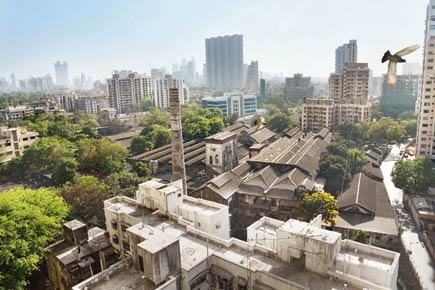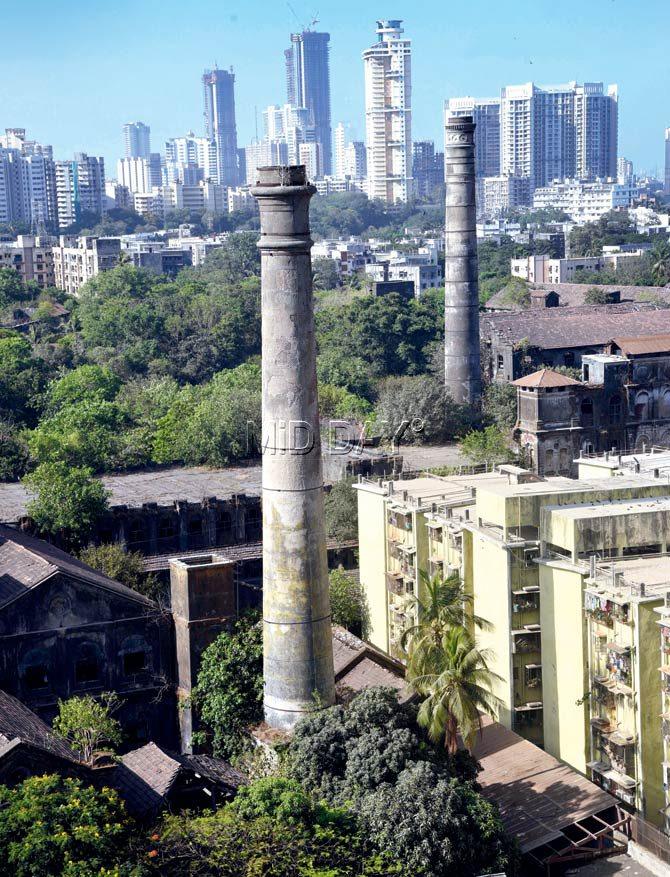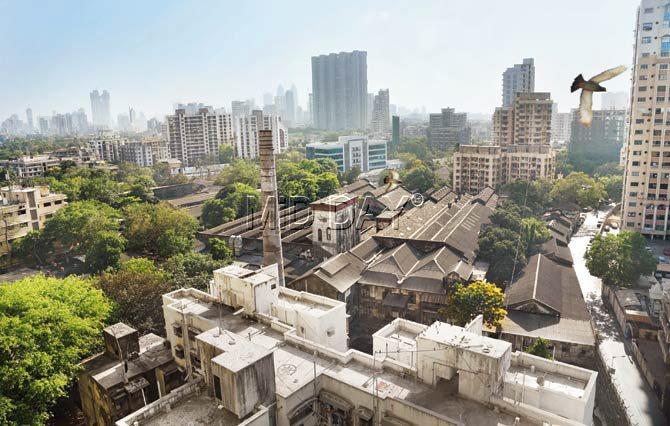As yet another mill chimney, this time in Byculla, bites the dust — only two mills remain in the city’s heritage list — are we erasing Mumbai’s industrial history?

"In those days, when we worked in the mills, we never thought that the chimneys would become a symbol of that life," says Datta Iswalkar, president of Girni Kamgar Sangharsh Samiti, a mill workers' union.

Chimneys of New City Mill and India United 2 (one of the two mills in the city with a heritage tag) inject the Byculla skyline against new urban projects. Pics/Suresh Karkera
ADVERTISEMENT
In Byculla, The New Great Eastern Mills, founded in 1839, was flattened earlier this year. While demolition was underway, the fate of its colossal chimney, overtaken by peepal saplings and a sight that could not be missed while scuttling down Lalbaug flyover, remained uncertain. Nestled in scaffolding, the chimney sent mixed signals. Was it being demolished? Or, was it being conserved? What would we see when the green curtain came down?

NTC’s India United 5 is one of the nine active mills in Mumbai. Having shifted to electric machines, its chimney is defunct but stands tall as a sign of a mill lands
Three weeks ago, New Great Eastern’s 187-year-old jumbo smokestack got knocked down. When we tell this to Iswalkar, who has seen through workers’ rights since 1987, his voice is laced with irritation. “Property developers should maintain it. A chimney is heritage.”

Wrapped up in scaffolding, the colossal chimney at The New Great Eastern Mills, now a property of Peninsula Land Ltd, went under the axe three weeks ago
Nothing could be further from the truth and Iswalkar is not ignorant of it. Only two mills earned the much-needed tag for conservation — India United 2 and 3, owned by the National Textile Corporation (NTC) — by the Municipal Corporation of Greater Mumbai (MCGM) in 2008. The rest, including private mills like New Great Eastern, and their infrastructure like spinning rooms, ponds and chimneys, are left exposed to the whims of developers and owners.
Stopped smoking
In 2013, Anurag Kanoria and Mahindra Lifespace Developers Ltd, jointly sold The New Great Eastern Mills to Peninsula Land Ltd, an Ashok Piramal Group firm, for about R650 cr. Kanoria is well-known in the city for his affable smile and his indulgent love for art. The latter has translated into a fine furniture store, The Great Eastern Home, and, more recently, a gallery, both in the mill premises. Kanoria used to open up the mill for various creative pursuits; parts of Detective Byomkesh Bakshi, the 2015 Bollywood release, were shot here, for instance.
The Great Eastern Home’s website pays homage to its chimney: ‘While the staccato rhythm of looms fusing warp with weft are only a distant memory, the chimney — the proud sentinel and iconic symbol of a veritable era — still stands tall, now serving as an unmistakable landmark, helping out visitors locate us from miles away.’
On a Wednesday afternoon, we enter what today looks like a five-acre wasteland. With rubble all around and dust rising in the air, it’s the prelude to Ashok Serenity, Peninsula’s residential project. At the far end of the rocky plot is Kanoria’s furniture store — a sprawling two-acre strip with a marble gazebo, a gigantic fountain and sunlight filtering through trees. Kanoria has preserved much of the original mill structures on this part, and says, “It was a commercial decision to sell the property. When I turned the godown into a gallery, keeping its stone walls and wooden structures intact, people told me it wouldn’t do as well as a restaurant. But it was a choice I made. It is easy to say that we must conserve mills as they have in Liverpool and Manchester. But, it is not an easy investment in India.”
And what of the chimney? “It falls in [Peninsula’s] property now, and they can do what they wish with it.”
Peninsula Land Ltd, which failed to respond to our queries, has reacted differently to chimneys in its other sites. At Peninsula Towers in Lower Parel, redeveloped from Dawn Mills, the chimney has been spared. The MCGM’s Building Proposal Department (BPD) and the Mumbai Heritage Conservation Committee (MHCC) tell us that the fate of all chimneys lies in the hands of owners and developers. “It is not mandatory but voluntary,” a BPD official puts it succinctly.
In the early 2000s, MLA Sachin Ahir recalls, the Rashtriya Mill Mazdoor Sangh approached Dosti Realty, which proposed to build four 25-storey towers in China Mills, Sewri. Today, a 2BHK flat at Dosti Flamingos costs Rs 2.95cr upwards; you get a swimming pool, indoor squash and badminton courts, and a club house. “We had demanded that they spare the mill’s temple and the chimney. Thankfully, the developers, on their own accord, retained the chimney,” says Ahir.
At one point, the chimney went hand-in-hand with the boiler room, from where steam, essential for strengthening yarn and cloth, was generated from coal furnaces.
But, the smoke-vent of the mill was more than just an indispensable unit. A smoking chimney was a sign of a healthy mill, says Ahir. “Once, there was no smoke seen from the chimney at Mafatlal Mills. At once, people knew something was wrong. Workers agitated about it for a day.”
In the nine mills that continue to function (four owned by the NTC, The Great Eastern Mill, and four more run by the NTC as garment units under joint partnerships), the chimneys are nothing but relics today. NTC’s India United 5, for instance, has now shifted to the use of electricity and generators, and there is little use for its towering vent.
A case for heritage
Artist Amol Patil, for whom Parel has been home for 29 years, takes us to New Hind Mill MHADA Colony, near Cotton Green. We take in a 180-degree view of Byculla from a fire escape balcony on one of the colony buildings. The Sewri coast glimmers on one side and chimneystacks are strewn across the other. The most prominent chimneys are around 200 ft tall, a height once thought to be as fitting to soar over the small-storeyed houses and chawls of yesteryear Girangaon.
The thought of an airbrushed concrete and glass skyline, with brick and stone chimneys erased out of it, sends a shudder down Patil’s spine. He says, “Growing up in Parel, two things were inescapable. The sound of mill sirens and smoke from the chimneys. As children, we failed to distinguish the two; we fooled ourselves into thinking that the siren calls came from the chimneys.”
Conservation architect Vikas Dilawari says, “Chimneys, with their smoke, were the skyline of central Mumbai, indicating that it was the Manchester of the East in the late 19th century.”
“A mill’s architecture was emphasised through chimneys and boiler rooms. Most chimneys bore the name of the mill, much like an advertisement,” he continues. There was a hierarchy, too — the more prominent the mill, the taller and wider its chimney.
As modern-day ziggurats and minars, chimneys stand out in the midst of urban clutter. But what Dilawari marvels in a chimney is its engineering. Most have decorative elements at the apex, like a festoon, to offset the stark industrial look of the mill. “Think about it — a century ago, it must have been difficult to round bricks and stones to make this circular structure in the absence of present-day cranes.”
With want of urgent conservation resuscitation, these colossuses are falling apart, their plaster peeling away and overtaken by weeds that parasitically eat into their structure. The state of neglect provides an easy excuse to tear down these shaky senior citizens of Mumbai’s industrial era. “Two-feet-high milestones have been considered heritage in the city, then why not chimneys? Why destroy these massive structures, these mute sentinels that mark one of the greatest industrial centres of the world?” says conservation architect Abha Narain Lambah.
Architect and urban researcher Neera Adarkar says, “It is sad that for the sake of some area of FSI, developers destroy chimneys. Irrespective of legalities, developers should maintain the city’s heritage.”
At Lower Parel’s Phoenix Mills, re-developed by the Ruias, the original chimney advertises the hip shopping mall, a siren call to the moneyed. Hub van Wersch, a Dutch anthropologist and author of Bombay Textile Strike 1982-83, criticised it in a piece he wrote for The Wire in October 2015: ‘It pains the eye to see a chimney of Phoenix Mills being incorporated in the snow-white world of Palladium shopping mall as a reference to the past. What will the ready-to-buy younger generation make of this strange white ‘ornament’? Will they realise that this object is central in Mumbai’s history? Is it showing a middle finger to the mills, to history?’
Lambah begs to differ. There is no harm, she says, in including a mill chimney into contemporary urban architecture. Instead of it going lock, stock and barrel, a chimney can be viewed as an urban sculpture that can be worked upon.
There is a big picture, however, that experts ask mill owners and developers to consider. It’s possible that razing an entire mill and preserving just a chimney is nothing but tokenism and a thorn in the side of ex-mill workers, reminding them of their loss. Artist Justin Ponmany, who made a series of works in 2004 inspired by the mills, says that the fallout of developers is the obsession with two words — ‘private’ and ‘residential’. In the face of former mill lands becoming playgrounds for the affluent, he says, “Mill lands need to be re-developed intelligently into spaces for the public to visit or to use rather than for gated communities.”
Dilawari agrees, suggesting, “It would be better to conserve a mill holistically, rather than just a chimney in isolation. Hospitals like KEM, for example, which keep crying out for space, can expand into old mills.”
But the path to heritage tags for mills entirely or chimneys specifically is not an easy one, Lambah and Dilwari will tell you. The two have been part of different studies (Dilawari was part of a group that studied NTC mills for the 1996 Charles Correa Committee Report; Lambah was part of a three-member committee appointed by the MCGM to review mill heritage), but the reports were disregarded.
Practicality and metaphor
In 2012, artist Prabhakar Pachpute made a drawing titled 16th January 1997, the day that Datta Samant, who led a year-long mill workers’ strike in 1982, was murdered by contract killers. The drawing depicted a tumbling mill chimney, much like a Tower of Babel lost to the city. “When Datta died, it was almost as if the city’s mills had fallen down,” he says.
The list of artists and filmmakers who have immortalised mill chimneys as metaphors for Mumbai’s changing landscape, class conflicts and the rule of commerce over industry is quite a long one. But former workers’ concerns are real, not symbolic.
Iswalkar points out a Maslowian hierarchy of priorities for his union. The sale of mill lands promises former workers a share in it through MHADA flats, an assurance earned by unions after a long fight. However, out of 1,48,000 mill worker applicants, only 6,923 have got MHADA flats so far. The case of the vulnerable chimneys, thus, is secondary to the economic crises faced by workers after mills started dropping like flies from 1982.
“But it is important for us that chimneys are given a heritage tag and conserved. Generations later, when our grandchildren ask us about the mills, these will be all that remain to tell them of our past and our long struggle,” he says.
 Subscribe today by clicking the link and stay updated with the latest news!" Click here!
Subscribe today by clicking the link and stay updated with the latest news!" Click here!







